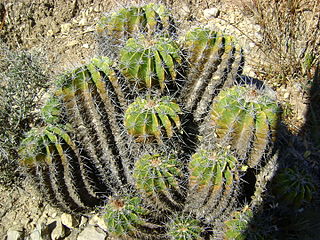
Isolatocereus is a monotypic genus of flowering plant in the family Cactaceae. The only species is Isolatocereus dumortieri that is found in Mexico.

Marshallocereus is a monotypic genus of flowering plant in the family Cactaceae. The only species is Marshallocereus aragonii that is found in Costa Rica, El Salvador, Guatemala, Honduras, Mexico, and Nicaragua.

Stenocereus griseus, also known as the Mexican organ pipe, dagger cactus, pitaya, and pitayo de mayo, is a species of cactus.

Ferocactus pilosus, also known as Mexican lime cactus or Mexican fire barrel, is a species of cactus in North America.

Cochemiea conoidea, common name Texas cone cactus or Chihuahuan beehive, is a species of cactus native to southern United States to central Mexico.

Ferocactus flavovirens is a species of Ferocactus from Mexico.

Ferocactus gracilis, the fire barrel cactus, is a species of Ferocactus from Northwestern Mexico. This cactus gets its common name from the striking red coloration of its defensive spines and flowers.

Echinocereus bonkerae, also known as pinkflower hedgehog cactus, Bonker hedgehog, or short spined strawberry cactus, is a species of hedgehog cactus.

Stenocereus pruinosus is a species of cactus. It is endemic to Mexico and occurs in the states of Veracruz, Puebla, and Oaxaca.

Stenocereus heptagonus is a species of cactus.
Stenocereus martinezii is a species of flowering plant in the family Cactaceae, native to Sinaloa in Mexico. A candelabriform cactus typically 5 to 7 m tall, it is easy to propagate from cuttings, so local people use it to build live fences.

Pachycereus weberi is a columnar cactus plant native to Mexico.

Cochemiea poselgeri is a species of Cochemiea found in Mexico

Echinocereus papillosus is a species of cactus native to Texas and Mexico.

Echinocereus barthelowianus is a species of cactus native to Mexico.

Echinocereus brandegeei is a species of cactus native to Mexico.

Echinocereus nicholii is a species of cactus native to Mexico.

Echinocereus sciurus is a species of cactus native to Mexico.
Stenocereus fricii is a species of cactus in the genus Stenocereus, endemic to Mexico.
Stenocereus chacalapensis is a species of cactus in the genus Stenocereus, endemic to Mexico.


















